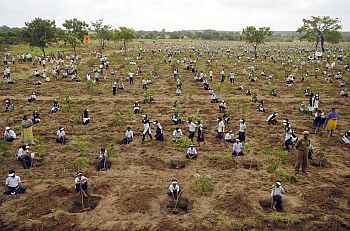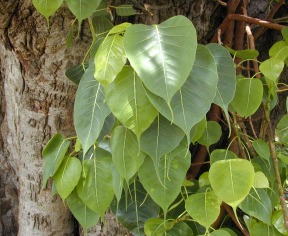Forest and trees
(An extreme view of tree plantation & a small example of practice)-Part I
-From "The Butterfly Diaries"

Its that time of the year when civic and nature organisations in India wake up from their slumber and begin to consider tree-planting yet again. Though this is an annual affair,
strangely India’s forest cover and biomass doesn’t seem to improve even where these activities are being carried out.
Typically, tree plantation begins with the collection of whatever dismal fare in saplings the forest department is willing to provide, followed by the desultory digging of holes and careless planting of trees. This activity, concluded in a couple of days in
the early monsoon, will be followed by a relapse into torpor. The final act is, of course, the appearance of a plague of self-publicised reports in the papers.
School-children plant trees as they take part in a "One day - One lakh plantation programme" on the outskirts of Hyderabad. Is this the way we should plant trees?

Over the next few months though, the thousands of saplings, thoughtlessly planted, are exposed to the harsh Indian environment accompanied by the complete neglect by the tree-planters.
The subsequent perishing of the year’s plantation by the end of the next summer (except for the minuscule few which by God’s grace actually manage to survive) should come as no surprise. And in the hallowed traditions of Hindu religious ideology, the kaal-chakra
turns to bring us back to tree-planting season again. Paradoxically, all of us feel good having participated in a worthwhile activity even though it is conducted so abominably.
Not all tree-planting is conducted this way. People plant carefully selected saplings to enhance their gardens and backyards. Some corporates do succeed in giving strikingly good tree-scapes and gardens to their campuses. Children all over carry out this activity
with the single-minded intensity of play. To them it is something well worth doing. A few civic organisations do exceptionally fine jobs of restoring plant cover and biodiversity to their favourite haunts. But these are a drop in the ocean when compared to
the morass of carelessly contrived tree-plantation schemes in our country.

The Pipal or Bo tree (ficus religiosa) (Image: Eric Guinther)
Hindu culture gives trees (or plants) an importance of their own. Planting a tree is said to be more fruitful than having a hundred sons. A number of trees figure in our pantheon
of objects worthy of worship – the Peepul Tree (Ficus religiosa) and Banyan (Ficus benghalensis) come immediately to mind. The Kalpavrisksh which fulfils the wishes of all, the Bo tree under which the Buddha gained enlightenment, the Aak (Calotropis spp) tree
under which Emperor Akbar was born are some examples of trees in our culture. Fragrant flowers are offered to our Gods in obeisance. Certain plants are associated with our deities – the “krishna” and “laxmi” varieties of Tulasi (Ocimum sanctum) and the Lord
Dattatreya’s fondness for the Umbar or Audumbar (Ficus racemosa) spring to mind.
Kalpataru, the divine tree of life. The wish-fulfilling bountiful tree is guarded by mythical creatures Kinnara and Kinnar. This bas-relief is the adorned wall of Pawon temple, an 8th century small shrine between Borobudur and Mendut temple, Java, Indonesia.

Above image by Gunkarta. Source : Wikipedia.
Yet, we tend to approach tree-plantation with less finesse than a three year old child.
Perhaps it is semantics. The term “tree plantation” implies that our job is just to plant – it’s nature’s business to do the rest. The truth is, if we want to really make a
difference, the business we should be in is “growing trees” not “planting trees”. That implies a whole lot more than partial burial of an juvenile plant in unprepared ground. The successful planting and growing of trees is not a rapid paced activity but takes
an enormous amount of time and effort. Accordingly, there is a need for thinking deliberately, planning and careful preparation before we get down to the plantation which is just one event in the long process of growing trees.
Maybe the reason is selfishness. In this materialistic world, there is nothing to be gained by labouring for unborn generations. In such a view point, tree plantation would
be meritorious only as a means for acclaim (for publicity and public adulation), getting rich (through corruption or by marketing one’s products) or as an indicator of performance (X planted more trees in his tenure than Y).
"Monocultures are ecological deserts. Tree plantations are not forests.
Another malaise in tree-plantation is mono-culture. It could be that most people do not realise that the planting trees of a single species, termed as mono-culture, is harmful. But the gaurdians of Indian forests should know. Invasive
trees take away more from our environment than their successful propagation. Yet it is the bureaucratic forces which have championed the cause of ecologically harmful exotic trees which grow quickly - such as Australian Acacia (Acacia auriculiformis), Kubabul
(Leucaena leucocephala) or the various forms of Eucalyptus – or even worse, the highly poisonous Jatropha curcas, purportedly for “bio-diesel”.
Jatropha curcas, the Physic Nut tree, is a poisonous, semi-evergreen shrub or small tree. Useful for biodiesel, it is ecologically useless.
It is the banal attitude towards tree plantation which reduces such a worthy activity to a pedestrian one that irks me greatly.
As far as growing trees is concerned, my own humble opinion can be summed up as :
Tree-planting is a craft. We should be “tree-smiths” – carefully crafting the environment in the manner that we make a Japanese garden, with each tree carefully chosen for effect, harmony, utility, importance, i.e. for a purpose. Growing trees is not meant
to be hedonistic or banal. It must be done spiritually – a kind of zen activity. It must be done to completeness. And the result must be healthy trees that give us the benefits we hoped for and more.
For that, we really need to know and love our trees.
-To be Continued......
|